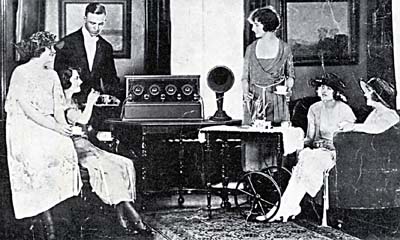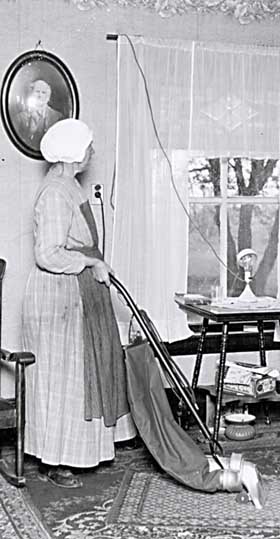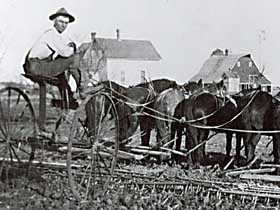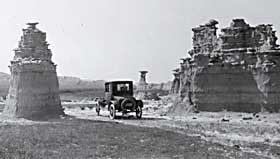Lesson 1
Dust and Depression
|
|
|
|

Photo from Ozarka Radio Catalogue, 1927
|
|
|
For most
Americans, everyday life changed after the First World War.
Families sat around their new radios. They listened to KGFX in
Pierre or WNAX in Yankton. They tuned in to radio
stations in New York City and Denver. They heard about amazing
things. There were electric irons and vacuum cleaners. Even
stoves and washing machines were now run by electricity. In
South Dakota, most families cooked on wood stoves. They washed
their clothes by hand. Few had electricity, but they knew it was
coming. It would make their lives easier, and at this time their
lives were hard. Soon dust and
depression made them even
harder.
|
|

Photo courtesy of South Dakota
State Historical Society
|
During the
First World War, a bushel of wheat sold for over $2.00.
Once the war was over, prices fell (you read about this in Unit 6).
By the end of 1920, a bushel of wheat sold for just 97˘. Yet, the
cost of farming stayed high. Farmers still had to pay for tools,
seed, livestock, feed, and the land itself.
Even before
the war, South Dakota looked for ways to make the
economy
stronger. People’s lives would be better if they had more money.
The state bought a coal mine in North Dakota. It built a cement
plant near Rapid City. It sold gasoline from state service
stations. Citizens could buy fuel and cement at lower prices. The
state also started a
rural credit system. It loaned money to
farm families to help pay for their homes and land.
|
|
|
|
|
Because farming
was so hard, something more had to be done. Senator Peter Norbeck
(you read about him in Unit 7) thought a new industry might help. It
was called tourism. People from other places were already coming to
the Black Hills. Tourists came to gaze at the Mitchell Corn Palace.
To bring more visitors, Norbeck started Custer State Park. The state
also
released thousands of Chinese ring-necked pheasants
in South Dakota. Soon there were large pheasant populations. The
birds brought hundreds of hunters. Tourists and hunters brought more
dollars to the state.
|

Photo courtesy of South Dakota State
Historical Society

Photo courtesy of South Dakota State
Historical Society
|
|
|
|
|

Photo courtesy of South Dakota State
Historical Society
|
Still, the
economy did not do well. South Dakota sold its coal mine. It gave up
its gasoline program. The rural credit system failed, and hundreds
of people lost their farms. Then in October 1929, the stock market
crashed.
The Great Depression swept over the whole country.
Factories
closed; people lost their jobs; and banks failed. Many families did
not have enough money to pay for their houses or farms. Men moved
from town to town, looking for work. Sometimes entire families
packed up and moved to California, Oregon, or Washington. They
thought life would be easier there. Instead, they found long lines
of people looking for jobs. People were hungry, out of work, or even
homeless. The Great Depression
gripped the entire United
States—and much of the world.
|
|
|
In South
Dakota, the land itself seemed to dry up with the economy.
Terrific dust storms swept across the plains. This area became
known as the Dust Bowl. At nine o’clock in the morning,
streetlights came on. "It was as dark as midnight,"
said a man from Sioux Falls. Great gusts of wind drove dust under
doors, around window frames, and through cracks in the walls. It
covered everything—inside and out. Mrs. Ben Huggins from
Geddes remembered that "the dust was so thick on the
bedspread, you couldn’t tell what color it was."
|
|
|
|

Photo courtesy of South Dakota State
Historical Society
|
|
|
Outside,
dust drifted over fence posts like snow.
Topsoil blew
away; crops failed. Then the grasshoppers came. "They came
and stripped the lilac bushes, just stripped them right
off," said Mrs. Huggins. The grasshoppers ate everything—garden
vegetables, wheat, and corn. Many people had to give up their
farms. When the Great Depression began, there were 692,894
people living in South Dakota. Almost fifty thousand moved away
in the next ten years.
|
| Vocabulary |
|
| crashed (v.), failed; lost its value
depression (n.), a period of business failure and lack of
jobs
economy (n.), the system of making, buying, and
selling goods and services
gripped (v.), kept a firm hold on something
|
released (v.), let go
rural (adj.), of the country
topsoil (n.), the top layer of soil that is fertile
|
|
|